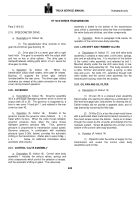TM-5-3805-254-14-P-2 - Page 696 of 894
TRUCK SERVICE MANUAL
valve directs pressure to the lockup clutch piston, which
causes the lockup clutch to engage.
Main pressure
applies the lockup clutch in models not equipped with
lockup cutoff valves.
When lockup cutoff valves (para2-
23) are included, clutch apply pressure from the drive
clutch engaged is used to apply the lockup clutch.
m. Priority Valve
(1)
The priority valve insures that the control
system upstream from the valve will retain sufficient
pressure during shifts to perform its automatic functions.
(2)
Without the priority valve, the filling of a
clutch might require a greater volume of oil (momentarily)
than the pump could supply and still maintain the
necessary control pressures.
O. Clutch Circuit, Drive Ranges
(1)
There are six clutches in the transmission.
These are:
low clutch; first clutch; second clutch; third
clutch; fourth clutch; and forward clutch.
The clutches
are applied for various conditions as follows:
Condition
Clutch(es) applied
Neutral.
..........................
Low
First gear .
......................
Low and forward
Second gear .
.................
First and forward
Third gear .
.....................
Second and forward
Fourth gear.
...................
Third and forward
Fifth gear .
......................
Fourth and forward
Reverse gear.
................
Low and fourth
(2)
Each of the six clutches has its own
circuit.
Each clutch except the forward clutch is
connected to a relay valve and a trimmer valve.
The
forward clutch is connected directly to the selector valve
and does not connect to a trimmer valve.
It does not
require connection to a trimmer valve because its
application (except in neutral-to first gear on the HT
750CRD and neutral-to second gear on the HT 750DRD)
precedes the application of an additional clutch which is
trimmed.
(3) The low clutch circuit connects the clutch to the
1-2 relay valve and to the low trimmer valve.
In neutral,
the 1-2 shift valve connects to the top of the 1-2 relay
valve.
As long as main pressure is at the top of the 1-2
relay valve, the valve cannot move.
Until the 1-2 shift
valve is charged by governor pressure, main pressure
will continue to hold the 1-2 relay valve down.
Therefore
hydraulic fluid is directed to only one clutch.
Since two
clutches are required to move the vehicle and since
governor pressure is negligible until the vehicle is
moving, neutral is maintained (refer to fig.
2-8).
(4) The low clutch in addition to being applied during
neutral operation, is also applied in first and reverse
gears.
Shifting the selector valve from neutral to drive 5
(D5) position or any other forward drive range (D4, D3,
D2, D1) charges the forward clutch circuit and applies
the forward clutch.
The low clutch remains charged.
Hydraulic fluid is directed from the selector valve to the
forward clutch.
It is also directed through the priority
valve to the 2-3 relay valve.
The unit is now in first gear.
Automatic shifting from first gear, progressively, to higher
gears (second, third, fourth, fifth) will occur when vehicle
speed increases.
The highest gear attainable, in
automatic shifts, is determined by the range selected
(refer to (7), below).
(5)
Shifting the selector valve from neutral to
reverse (R) charges the fourth clutch, while the low
clutch remains applied.
In reverse, fourth clutch (reverse
signal) pressure is also directed to the bottom of the 2-3
relay valve.
The pressure at this point prevents the relay
valve from moving downward during reverse operation.
(6)
When the circuits are charged, as
described for the shift to drive 5 (D5), above, any forward
shift from first to second, second to third, third to fourth,
and fourth to fifth can occur automatically.
These shifts
occur as a result of rear governor pressure.
At less than
full throttle, modulation will assist governor pressure.
689
TRANSMISSION
Back to Top




















